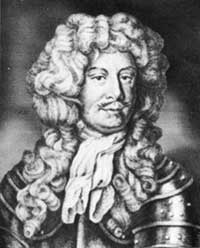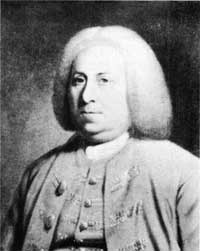|
FORT NECESSITY National Battlefield |
 |
The Fort Necessity Campaign (continued)
 The Marquis Duquesne, Governor General of Canada, 1752—55. Public Archives of Canada. |
WASHINGTON'S MISSION TO FORT LE BOEUF. The French continued their activities. The new Governor General of Canada, the Marquis Duquesne, sent out an expedition of 1,000 men to build a series of three forts in this region. Forts Presque Isle (near the present city of Erie) and Le Boeuf (in present Waterford) were built in the early summer of 1753. By the time they were completed, however, sickness and the lateness of the season prevented the construction of the third fort. The English trading post at Venango at the junction of French Creek and the Allegheny River (where Franklin is now located) was seized and occupied. Leaving a force to garrison the new posts, the French command returned to Canada for the winter.
News of these developments startled the middle colonies, who were nearest to the zones of friction, and especially alarmed Lt. Gov. Robert Dinwiddie of Virginia. He immediately sent a solemn warning to Legardeur de Saint Pierre, commandant at Fort Le Boeuf, accusing the French of trespassing on the domain of His Majesty, and stating "It is so notoriously known that the Lands on the Ohio River to the West of the Colony of Virginia belong properly to the Crown of Great Britain." Learning of Dinwiddie's letter, Canada's Governor General Duquesne countered "His claims on the 'Belle Riviere' are a real chimera, for it belongs to us incontestably. Moreover, the King wants it, and that is enough to march ahead." It was clear that the issues were beyond the stage of peaceful settlement.
 Robert Dinwiddie, Lieutenant Governor of Virginia. From Douglas Freeman, George Washington, Vol. I. Courtesy Charles Scribner's Sons. |
On October 31, 1753, Governor Dinwiddie appointed one of his adjutants, Maj. George Washington, then 21, to warn the French to withdraw from the Ohio. With Christopher Gist as guide and the Dutch adventurer Jacob Van Braam as interpreter, Washington's party of eight men began the journey through the hazardous frontier country. In the face of winter storms, the little band of men reached the forks of the Ohio (now the site of Pittsburgh) and thence down that river about 17 miles to the Indian village of Logstown. After parleys here with the Indians, Washington continued his journey northward. At Venango, where Celoron had recently dispossessed the Englishman, John Frazier, of his trading post, Washington was received by Capt. Philippe Joincare, the commandant. Joincare referred him to Saint Pierre, the commandant at Fort Le Boeuf. Continuing his march, Washington was now accompanied by the Half King (Tanachariston), a friendly chief of the Senecas, known in this region as the Mingoes, one of the six Iroquois Nations.
The envoy was received at Le Boeuf with marked politeness by the French authorities. In reply to Dinwiddie's demand that the French withdraw, the commandant, Legardeur de Saint Pierre, informed Washington that he would hold possession of the Ohio country for France until he received other orders from his superior, the Marquis Duquesne. Meanwhile, the French endeavored to win over the Half King and his Indians. While he accepted a gun and other presents from the French, the Half King nevertheless remained loyal to the English.
Washington returned homeward, after several exciting and dangerous experiences on the way, and delivered the French reply to Dinwiddie at Williamsburg. His mission, however, was not wholly a failure. The young major had taken advantage of the opportunity to learn something of the delicate art of Indian relations, and had gained a firsthand knowledge of French military strength.

|

| History | Links to the Past | National Park Service | Search | Contact |
|
Last Modified: Mon, Dec 2 2002 10:00:00 am PDT |

